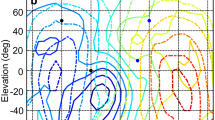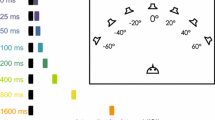Summary
Lateralization of interaural time difference by barn owls (Tyto alba) was studied in a dichotic masking experiment. Sound bursts consisted of two parts: binaurally time-shifted noise, termed the probe, was inserted between masking noise. The owls indicated that they detected and lateralized the time-shift in the probe by a head turn in the direction predicted from sign of the time-shift.
The general characteristics of head turns in response to this stimulus was similar to the head turns elicited by free-field stimulation or to head turns in response to presentation of the probe alone.
The owls could easily lateralize stimuli containing long probes. The number of correct turns decreased as probe duration decreased, demonstrating that the masking noise interfered with the owls' ability to lateralize the probe. The minimal probe duration that the animals could lateralize (“minimal duration”) became shorter as burst duration decreased. Minimal durations ranged from 1 ms to 15 ms for the two subjects and burst durations from 10 to 100 ms.
These findings suggested that owls possess a temporal window. A fitting procedure proposed by Moore et al. (1988) was used to determine the shape of the temporal window. The fitting procedure showed that the shape of the owls' binaural temporal window could be described by the same algorithms as the human monaural temporal window. Thus, the temporal window is composed of a short time constant that determines the central part of the window, and a longer time constant that determines the shape at the skirts of the window.
Similar content being viewed by others
Abbreviations
- ERD :
-
equivalent rectangular duration
- ILD :
-
interaural level difference
- ITD :
-
interaural time difference
- RSE :
-
relative signal energy
- SNR :
-
signal-to-noise ratio
References
Blauert J (1983) Spatial hearing. MIT Press, Cambridge/MA
Boer E de (1985) Auditory time constants: a paradox? In: Michelsen A (ed) Time resolution in auditory systems. Springer, Berlin Heidelberg New York, pp 141–158
Dooling RJ, Searcy MH (1985) Temporal integration of acoustic signals by the budgerigar (Melopsittacus undulatus). J Acoust Soc Am 77:1917–1920
Fay RR (1985) Sound intensity processing by the goldfish. J Acoust Soc Am 78:1296–1309
Giraudi D, Salvi R, Henderson D, Hamernik R (1980) Gap detection in the chinchilla. J Acoust Soc Am 68:802–806
Green DM (1985) Temporal factors in psychoacoustics. In: Michelsen A (ed) Time resolution in auditory systems. Springer, Berlin Heidelberg New York, pp 122–140
Klump GM, Maier EH (1989) Gap detection in the starling (Sturnus vulgaris): I. Psychophysical thresholds. J Comp Physiol A 164:531–538
Knudsen EI, Konishi M (1979) Mechanisms of sound localization in the barn owl (Tyto alba). J Comp Physiol 133:13–21
Knudsen EI, Blasdel GG, Konishi M (1979) Sound localization by the barn owl (Tyto alba) measured with the search coil technique. J Comp Physiol 133:1–11
Konishi M (1973) How the owl tracks its prey. Am Sci 61:414–424
Konishi M, Takahashi TT, Wagner H, Sullivan TE, Carr CE (1988) Neurophysiological and anatomical substrates of sound localization in the owl. In: Edelman GM, Gall WE, Cowan WM (eds) Functions of the auditory system. Wiley, New York, pp 721–746
Moiseff A (1989) Bi-coordinate sound localization by the barn owl. J Comp Physiol A 164:637–644
Moiseff A, Konishi M (1981) Neuronal and behavioral sensitivity to binaural time difference in the owl. J Neurosci 1:40–48
Moore BCJ, Glasberg BR, Plack CJ, Biswas AK (1988) The shape of the ear's temporal window. J Acoust Soc Am 83:1102–1116
Munson WA (1947) The growth of auditory sensation. J Acoust Soc Am 19:584–591
Olsen JF, Knudsen El, Esterly SD (1989) Neural maps of interaural time and intensity differences in the optic tectum of the barn owl. J Neurosci 9:2591–2605
Penner MJ, Robinson CE, Green DM (1972) The critical masking interval. J Acoust Soc Am 52:1661–1668
Pollack I (1978) Temporal switching between binaural information sources. J Acoust Soc Am 63:550–558
Sokal RR, Rohlf FJ (1981) Biometry, 2nd edition, Freeman, New York
Wagner H, Konishi M (1988) Schallrichtungswahrnehmung im azimuthalen Ortungssystem von Schleiereulen (Tyto alba) bei kurzen Reizen. Verh Deutsch Zool Ges 81: p 217
Zwislocki J (1960) Theory of temporal auditory summation. J Acoust Soc Am 32:1046–1060
Author information
Authors and Affiliations
Rights and permissions
About this article
Cite this article
Wagner, H. A temporal window for lateralization of interaural time difference by barn owls. J Comp Physiol A 169, 281–289 (1991). https://doi.org/10.1007/BF00206992
Accepted:
Issue Date:
DOI: https://doi.org/10.1007/BF00206992




